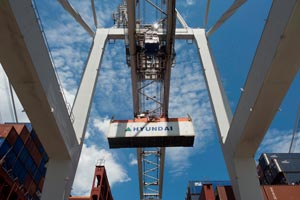'We're Out of Space,' Georgia Ports Authority Says

Anyone looking for independent proof that Georgia Ports Authority is the fastest-growing container port in the country need look no further than the area’s historically low industrial vacancy rates.
With developers and contractors scrambling to catch up to demand, industrial vacancy rates in the area — think warehouses, distribution centers and the like — finished 2015 at the lowest year-end point ever recorded.
At the end of the fourth quarter, overall available space was at a paltry 3%, while availability in 100,000 square feet and up — known as bulk inventory — was even lower at 2.7%.
“The market is starting to respond with some speculative building underway, but it’s still very low,” said David Sink of Colliers International in Savannah, which publishes an industrial market report every quarter.
Vacancy rates in the five-county Savannah area hit an all-time quarterly low in the third quarter of 2015 with 2.25% overall vacancy and 1.1% in the bulk category.
“So, they came up slightly at the end of the year, which is a positive sign, but the numbers are nowhere near meeting the demand,” Sink said.
Presently, some half-dozen companies — with projects in various stages of development — are pursuing build-to-suit options because they can’t find available speculative space to fit their needs, Sink said.
“Of course, building from the ground up takes longer and can cost more.”
At any rate, it’s a slow process, averaging a year to 18 months to put up a building, depending on size and use.
And time is of the essence, according to Georgia Ports chief Curtis Foltz.
With containerized cargo volume for the past two years up 700,000 — a total of 23% — the state’s ports continue to lead container growth in the country, Foltz told his board Feb. 1.
The port moved a record-breaking 3.73 million TEUs — or 20-foot equivalent units — in 2015, an 11.7% increase over 2014, which also was a record-breaking year.
Even with December numbers down from the same month a year ago, last month was the second-highest December on record, Foltz said, giving the port container volumes it wasn’t expecting to see until 2018.
As those numbers grow, so does the demand for warehouse and distribution space.
Total industrial inventory at the end of the fourth quarter was 46.5 million square feet, with only 1.1 million square feet vacant. Another 3.2 million square feet is under construction.
Of the buildings under construction, five are speculative and four are being built for customers.
With a 200,000-square-foot expansion for Nordic, a 230,000-square-foot expansion for Port City Logistics, a 200,000-square-foot build for Peeples Industries and a 1.1 million-square-foot building for JLA Home, the build-to-suit properties comprise the lion’s share of new builds.
Speculative construction underway includes a 315,000-square-foot building for Chicago-based Center Point development that is close to completion, as well as 475,000 square feet and 320,000 square feet under construction for two separate Atlanta developers.
To say that’s not enough is an understatement, Foltz said Jan. 29.
“Available industrial space has dwindled to historic low levels,” he said. “The market demand is currently very high for space, and additional capacity can’t come on line quick enough.”




